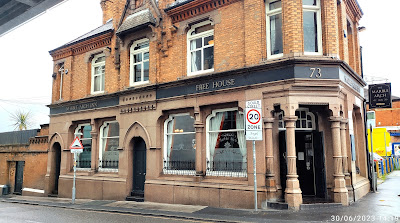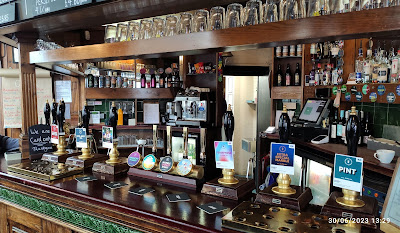One method of ensuring a clear and attractive looking drink for the consumer, was to leave the partially finished beer in the fermenter or subsequent maturation vessel to drop right of its own accord. This could be quite time consuming, so the discovery of finings, such as isinglass, was an important one, especially as it sped up the process by several orders of magnitude. Finings work by causing yeast cells, suspended in the maturing beer, to clump together, so they eventually drop out of suspension, leaving a bright and sparkling end product.
 This method was used for ages, but the adoption of filtration
as a method to clarify beer, took things to a whole different level, especially
with the advent of pressure filtration systems. Filtration is the method most
commonly used today, and it is widely used for virtually every type of beer, with
the honourable exception of cask conditioned ale. The latter, still relies on
finings, added to the beer after racking, to achieve a clear, bright pint, but
it is hamstrung by the live yeast that remains at the bottom of the cask.
This method was used for ages, but the adoption of filtration
as a method to clarify beer, took things to a whole different level, especially
with the advent of pressure filtration systems. Filtration is the method most
commonly used today, and it is widely used for virtually every type of beer, with
the honourable exception of cask conditioned ale. The latter, still relies on
finings, added to the beer after racking, to achieve a clear, bright pint, but
it is hamstrung by the live yeast that remains at the bottom of the cask.
Careless handling, or not allowing sufficient time for the beer to clear and the yeast to settle, can result in a hazy, or downright cloudy pint, but the majority of cellarmen and licensees are experienced enough not to let this happen. Indeed, those of us who've been drinking cask ale for a long time, have grown to expect a beer which looks bright end sparkling in the glass, and most drinkers worth their salt would quite rightly return a glass of beer that doesn't look right.
Occasionally, despite the best practices in the cellar, a cloudy pint can still get through and this is where the difference between a good and a bad licensee comes into play. The publican who knows what he or she is doing, will change a dodgy pint without question, and also take steps to find out why such a situation occurred. Cloudy beer is either due to insufficient maturation time, or the cask is fast approaching empty, and the sediment in the “belly” of the cask, is being drawn up through the lines and into the customer’s glass. An inexperienced or sometimes unscrupulous licensee would claim that “It's real ale and it's supposed to look like that!” Over the years that untruthful and rather pathetic excuse has fortunately disappeared, or at least most of us thought it had, until the rise of so-called craft ale/craft keg. Many of these beers are unfiltered, and also un-fined, the excuse being it’s a more natural product, but whilst this this may well be true, the fact that the kegs still contain live yeast, is bound to result in a cloudy pint. Worse still, rather too many of these “natural” beers don't just have a slight haze but are what many of us have come to describe as “craft murk.” In other words, they are thick, turbid, and just look completely wrong in the glass. The argument put forward by craft devotees is these beers are supposed to be like that – sounds familiar, although who exactly said that, and when they made such a declaration remains a mystery. The plot thickens further, if you’ll pardon the pun, as it turns out that some new styles of beers are designed to deliberately appear cloudy, murky if you prefer because “That's what they're supposed to be like.” This is the claim put forward by the brewers who produce these murky beers and the outlets that sell them. Probably the worst offender here is the style known as New England IPA, or NEIPA for short. As far as I'm aware this is a totally made-up faux style of beer, but unfortunately due to hype, peer pressure, the rise of beer ticking - Untappd, and sites such as Rate Beer, where subscribers sing their praises, or otherwise, NEIPAs and other cloudy/murky beers have acquired a large following. To me this is yet another case of the "emperor's new clothes", as no one is prepared to call out the people promoting this false style of beer. I say false because the group of small American states in the far northeastern corner of the USA that constitute New England, never had much of a tradition of brewing India Pale Ale. However, as with West Coast IPA, and also East Coast, the term India Pale Ale has become seriously debased, just for the purpose of making money from selling craft murk to gullible people.I'm not even sure how they make these beers so deliberately cloudy. Does the end product have a surplus of yeast or is the “milkshake” appearance of NEIPA down to bad brewing techniques? Normally, trub, which is the protein and spent hop residue leftover from the brewing process, is left behind in the copper or whirlpool, rather than being allowed to make its way into the fermenter, so is it this protein haze, or other, suspended matter that gives the beer its orange juice like appearance? Perhaps it is no coincidence that aficionados of these beers describe them as being “juicy.”
Personally, I prefer my beer to taste of malt and hops, rather than orange or pineapple, because that's what much of this craft murk stuff looks like when served up. Unfortunately, this type of nonsense has undone much of CAMRA’s good work when it comes to promoting good cellar practises. So now a bar person, with very little knowledge of beer, can quite truthfully trot out the excuse it's supposed to look like that, when serving up a glass of murk to an unsuspecting customer.
I was reminded of this on Friday, when I called in at a well-known local beer emporium in Tonbridge. There was a range of beers including two from Iron Pier Brewery of Gravesend. I opted for the Wealdway IPA, the Wealdway being a long-distance footpath running right across the Kent & Sussex Weald, from Gravesend on the Thames Estuary to Eastbourne, overlooking the English Channel. A friend and walked this particular trail back in 2010, so Wealdway IPA seemed a rather fitting beer, as it brought back special memories. The barman pulled me a pint, but when I went to pay for it, I noticed the beer was taking a long time to clear in the glass. I asked if it was supposed to be a hazy beer, and was told, “yes.” I wasn’t impressed, as had I known this, I wouldn’t have ordered it, but having paid for it, was willing to give it a try. Fancying a spot of al fresco drinking, I took my pint outside and began drinking it. The beer was all OK, but despite what some might argue, whatever was causing the haze, spoiled the taste, and it certainly wasn't the perfect marriage of malt and hops one would normally expect from an IPA. Whilst prepared to put this down to experience, I was a little peeved there was no POS material on the bar, or the plump clip, advising that this beer was supposed to be hazy. When I went to “tick” the beer on Untappd, I noticed a friend from West Kent CAMRA had ticked the same beer at the same outlet a couple of hours before me. He too thought the beer should not have been murky, so I messaged him said the same thing.When I'd finished the beer, I returned the glass, but this time there was a different person behind the bar. I expressed my dissatisfaction with the beer and informed him that a friend had also questioned its cloudiness and posted about it on Untappd. Following my disclosure, the beer was removed from sale, as it was either coming to the end of the cask, or possibly it hadn't dropped right bright in the first place. Whatever the reason it should not have been served, but obviously mistakes can sometimes occur, even in the best run establishments.
Once the error was highlighted, the pub acted in the right way by removing the offending beer from sale. The barman apologised and asked if I'd like another beer instead. I declined this kind gesture, primarily because I needed to get home. Had I been a bit more on the ball I could at least asked for a stamp on my pub loyalty card, the one they use to promote cask ale. One stamp per pint, and after 10 stamps the card holder is rewarded with a free pint.I’ve droned on too long, but wanted to make the point about the way craft murk has muddied the water. For the record, and just to make sure I wasn’t talking out of my rear end, I checked Iron Pier’s website, as well as on Untappd, and like any other self-respecting cask ale, Wealdway IPA is supposed to drop bright. Vigilance pays in these uncertain times!























































